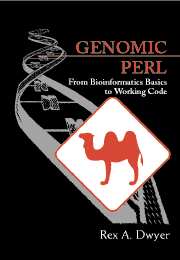Book contents
- Frontmatter
- Contents
- Preface
- Acknowledgments
- 1 The Central Dogma
- 2 RNA Secondary Structure
- 3 Comparing DNA Sequences
- 4 Predicting Species: Statistical Models
- 5 Substitution Matrices for Amino Acids
- 6 Sequence Databases
- 7 Local Alignment and the BLAST Heuristic
- 8 Statistics of BLAST Database Searches
- 9 Multiple Sequence Alignment I
- 10 Multiple Sequence Alignment II
- 11 Phylogeny Reconstruction
- 12 Protein Motifs and PROSITE
- 13 Fragment Assembly
- 14 Coding Sequence Prediction with Dicodons
- 15 Satellite Identification
- 16 Restriction Mapping
- 17 Rearranging Genomes: Gates and Hurdles
- A Drawing RNA Cloverleaves
- B Space-Saving Strategies for Alignment
- C A Data Structure for Disjoint Sets
- D Suggestions for Further Reading
- Bibliography
- Index
15 - Satellite Identification
Published online by Cambridge University Press: 05 June 2012
- Frontmatter
- Contents
- Preface
- Acknowledgments
- 1 The Central Dogma
- 2 RNA Secondary Structure
- 3 Comparing DNA Sequences
- 4 Predicting Species: Statistical Models
- 5 Substitution Matrices for Amino Acids
- 6 Sequence Databases
- 7 Local Alignment and the BLAST Heuristic
- 8 Statistics of BLAST Database Searches
- 9 Multiple Sequence Alignment I
- 10 Multiple Sequence Alignment II
- 11 Phylogeny Reconstruction
- 12 Protein Motifs and PROSITE
- 13 Fragment Assembly
- 14 Coding Sequence Prediction with Dicodons
- 15 Satellite Identification
- 16 Restriction Mapping
- 17 Rearranging Genomes: Gates and Hurdles
- A Drawing RNA Cloverleaves
- B Space-Saving Strategies for Alignment
- C A Data Structure for Disjoint Sets
- D Suggestions for Further Reading
- Bibliography
- Index
Summary
We have already learned that the process of DNA replication is not perfect and that, in fact, this is a source of mutations both beneficial and deleterious in sequences encoding amino acid chains and regulating their production. Intergenic (“junk”) DNA is also subject to mutations, and since these mutations pose no impediment to survival, they are preserved at much greater rates than mutations to coding and regulatory sequences. In such DNA, it is common to find tandem repeats consisting of several contiguous repetitions of the same short sequence.
The repetitions themselves may vary slightly as a result of point mutations. Furthermore, individuals within a population often carry different numbers of repetitions as a result of deviations from normal DNA replication. For example, the feature known as HUMHPRTB, which consists of varying numbers of repetitions of AGAT, was found to exist in nine different forms in a group of 417 humans; 314 group members carried two different forms or alleles. The sites of such variation are collectively called VNTR (variable number of tandem repeat) loci. Since mutations at VNTR loci are so frequent – up to 1% per gamete per generation – and are inherited, they form the basis of the highly publicized “DNA fingerprinting” techniques used to resolve paternity disputes and to free the wrongfully incarcerated. VNTRs can also be powerful tools for reconstructing pedigrees and phylogenies.
VNTR sequences, or satellites, are commonly subdivided into two categories, which originate by distinct processes.
- Type
- Chapter
- Information
- Genomic PerlFrom Bioinformatics Basics to Working Code, pp. 245 - 256Publisher: Cambridge University PressPrint publication year: 2002



